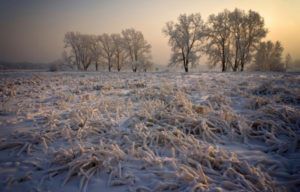

Several scales have been defined, but the most commonly used are (1) local magnitude (ML), commonly referred to as "Richter magnitude", (2) surface-wave magnitude (Ms), (3) body-wave magnitude (Mb), and (4) moment magnitude (Mw). Magnitude is based on measurement of the maximum motion recorded by a seismograph. The magnitude is a number that characterizes the relative size of an earthquake. Most people are familiar with the "Richter scale," but there is a bit more to the discussion. Yep, cryoseisms can be measured using the same scale referenced in more common earthquakes. A recent paper in the Canadian Journal of Earth Sciences documented some of the larger lake-associated ice quakes (ML 2.0). While cryoseisms are somewhat uncommon in the popular literature (until now), people that live in very cold climates may be more familiar with them. And that can explain the earthquake light and lightning type effects that we see."

And of course earthquakes are really due to squeezing and then release of that pressure as the rock cracks and moves. There are electrical changes that happen in rocks when they get squeezed. What in the world is that about? John Ebel addressed this question during an interview with the The Weather Notebook many years ago: Edward Colon, an atmospheric physicist in Maryland, alerted me that ice quakes have also been identified in non-seismic activity. Scientists have observed ice quakes during the process of glacial calving.īy the way, some people often report seeing flashes of light with cryoseisms. You may not have heard of them until now. Ironically, like the Polar Vortex, these terms are not new. You may also see the term ice quake used to describe a cryoseism. Once the pressure is too great, it is relieved violently-a fracture on the surface forms and a loud, explosive noise echoes within the proximity of the breakage! The surrounding frozen surface can withstand the increase in pressure from the expansion of ice for a while, but not for as long at very low temperatures and high pressures. This continuous expansion imposes a large amount of stress on the local surrounding frozen soil and rock around the ice. The subsurface ice continues to expand as the temperature cools because water molecules, upon cooling, arrange themselves into a structure that takes up more volume than when the molecules were arranged in a liquid. According to a 2015 paper by Steven Battaglia and David Shannon in Weatherwise magazine, When the temperatures plunge rapidly below freezing, subsurface water can freeze and expand. The Kelvin scale is a temperature scale that has no negative values - but I digress. With the most recent Polar Vortex infusion of cold air, temperatures have been well into minus values in the Midwest and wind chills were in the -60 to -70 degree F range. By the way, what does a minus temperature mean anyhow? You never see length given as -10 kilometers or mass as -50 grams.

With this foundation, you may be putting some things together, but let's do it formally.ĭuring winter or very cold outbreaks, the temperatures can cool rapidly from above 32 degrees F to below freezing (graphic above). According to Merriam-Webster's online dictionary, the word "seism" is a less common word for the "earthquake." The word "cryo" is associated with cold or extreme cold. My Forbes colleague Robin Andrews wrote about frost quakes recently, but I wanted to dive more into the science. The root words give you a clue. The scientific term for a "frost quake" is cryoseism.


 0 kommentar(er)
0 kommentar(er)
